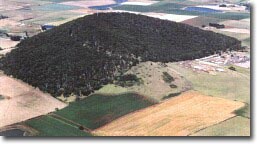Mount Warrenheip
|
This information has been obtained from the report: Eruption Points of the Newer Volcanic Province of Victoria by Neville Rosengren. This report was published in 1994 and was prepared for the National Trust of Australia (Victoria) and the Geological Society of Australia (Victorian Division). The review of eruption points was based on an earlier unpublished manuscript Catalogue of the post-Miocene volcanoes of Victoria compiled by O P Singleton and E B Joyce (Geology Department, University of Melbourne 1970). |
| Location: | 37 34 30S 143 57 30E (external link); 7622-1-1 (Warrenheip) 600367. 9 km E of Ballarat. Forbes Road. |  Mount Warrenheip. |
Buninyong. | ||
Land Tenure/Use: | Public land on top half, surrounded by private land. Access road to top. Forested, no outcrop. | |
Type 5: | Scoria cone with crater. | |
Mount Warrenheip is a composite breached scoria cone from which issued a number of lava flows. There is a deep, well-defined central crater which has been breached on the northern side. On the southern side, the cone rises abruptly above older weathered lava flows but the topography around the northern side is irregular as younger lava flows issued from here via the explosive breach of the cone. These lava are dated at 2.53 (+/-) 0.15 million years. Small parasitic lava vents occur around the base. With 170 m of local relief, Mount Warrenheip is one of the higher scoria cones in Victoria. The lavas include olivine-rich xenoliths and megacrysts of clinopryoxene and orthoclase. Road cuttings expose coarse volcanic agglomerate and thin pods of lava. | ||
741 m; 170 m. | ||
Regional: | A major example of a breached scoria cone although not as obvious as Mount Buninyong. It is one of the few major scoria cones substantially in public ownership and forested. It is an important megacryst site. | |
References: | Hills, E.S. 1940. The physiography of Victoria (1st edn). Whitcombe & Tombs, Melbourne. Yates, H. 1954. The basalts and granitic rocks of the Ballan District. Proceedings of the Royal Society of Victoria 66, pp. 63-101. Irving, A.J. & Green, D.H. 1976. Geochemistry and petrogenesis of the Newer Basalts of Victoria and South Australia. Journal of the Geological Society of Australia 23 (1), pp. 45-66. King, R.L. 1985. Explanatory notes on the Ballarat 1:250 000 geological map. Geological Survey of Victoria Report 75. | |


